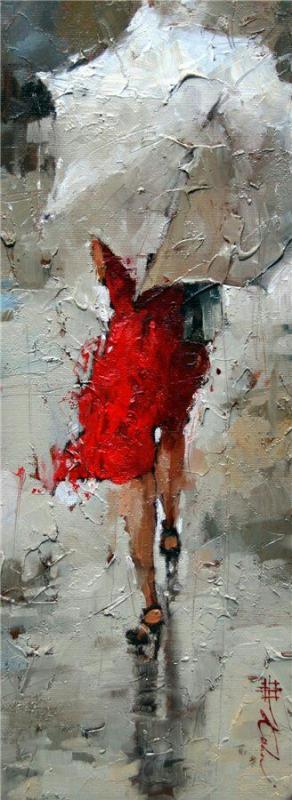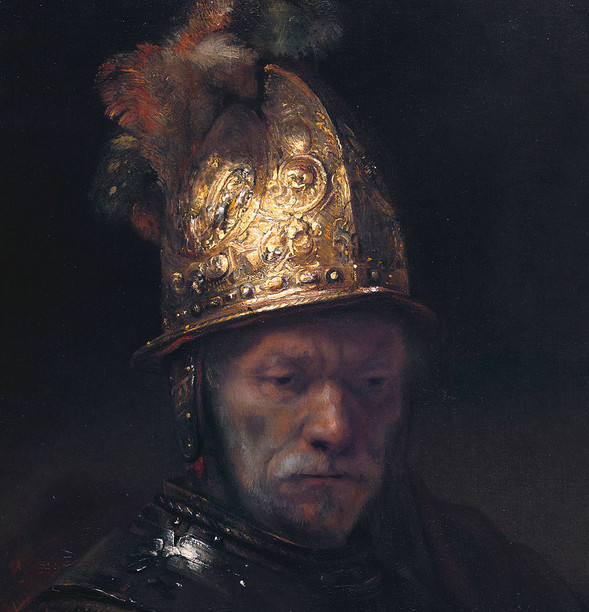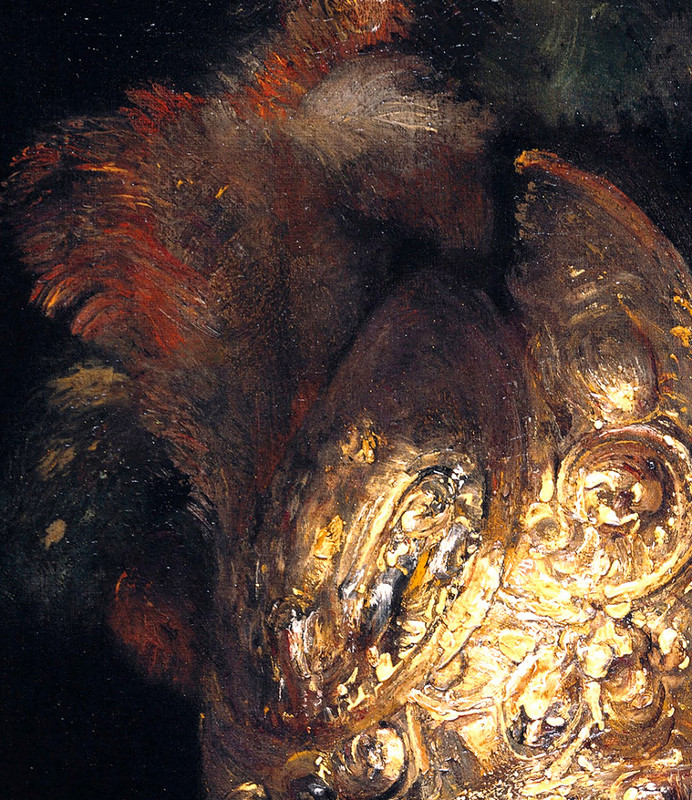Home › Forums › Explore Media › Oil Painting › Impasto technique question
- This topic has 15 replies, 9 voices, and was last updated 6 years, 2 months ago by
 Robin.
Robin.
-
AuthorPosts
-
January 21, 2018 at 11:49 am #449867
 Anonymous
Anonymous
Dear my fellow artist friends…
From what i understand, impasto is when you apply thick blob of paint to make texture on regular surface. Recently i found this painting by andre kohn. What do you think about the texture? I’m trying to understand what the painter did. I like this textured effect. When i look closely at this painting (by zooming in) i think the painter did the texture first, perhaps using gesso with knife, because there is no texture inbetween color change (ie just pay attention to where the umbrella meets the background color) and then paint smoothly afterward. Is this considered impasto too? If yes, so it means there are 2 types of impasto? 1. using thick paint on regular smooth surface 2. Painting regularly using textured surface. Please enlighten me. Thanks everyone.
Thanks everyone. January 21, 2018 at 3:08 pm #549434
January 21, 2018 at 3:08 pm #549434If you go here, you’ll see the following description of Kohn’s technique:
“In fact, one of Kohn’s signature structural elements is his preparation of each surface. He layers modeling paste onto the blank canvas before he ever makes a mark, thereby creating an intrinsically dimensional composition. Such a process makes the texture part of the painting itself, not simply a visual overlay.”
Looking at other examples of his work, it appears that the texture sometimes follows the forms, and sometimes seems unrelated to them. Perhaps he draws the design before applying the modeling paste; perhaps he does not.
It appears that he does work from photo ref. The photo used for the painting you’ve reproduced here apparently also served as reference for a larger work seen here[/URL].
Although Kohn is often described as a knife painter, I suspect that the modeling paste is applied with a knife, while the paint itself is applied with a brush.
January 21, 2018 at 4:10 pm #549424Yeah, many painters do exactly that–they apply all sorts of texture to their acrylic canvas preparation, and then just perform “normal” painting operations to their actual painting.
Personally, I think that is rather “hokey”, and doesn’t exhibit much creativity on the part of the artist, at least not as much dexterity as would be required to actually apply the paint, with all its color and value breaks as he/she creates the painting.
It doesn’t require nearly as much skill to create impasto on a flat surface when priming the canvas as it does to create impasto brush strokes, or knife applications of paint.
wfmartin. My Blog "Creative Realism"...
https://williamfmartin.blogspot.comJanuary 21, 2018 at 7:43 pm #549429 Anonymous
Anonymous
Thank you JCannon and WFMartin.. So I was right to some extent. Yesterday I also watched Kevin from youtube https://m.youtube.com/watch?v=4aDBdM7G1Do probably just going to try that. Painting with palette knife. I’m afraid that ifbI use Kohn technique, I will be crazy again about details and ends up painting realistically again. Trying to be loose here..
January 23, 2018 at 7:28 pm #549436Rembrandt used impasto techniques to get increased realism.. apparently his impasto is still not very thick in absolute terms…

you have to be careful with how you create thick blobs of paint if you want to paint for posterity.. I believe that using some sort of glass powder is probably OK or some sort of specially designed impasto medium, which probably has the glass or sand powder in it anyway, apparently Rembrandt did use silica of some sort.. He made very convincing skin textures using impasto… the most famous texture is probably his man with a golden helmet… the fine 3D impasto relief in the underpainting, combined with a very thin glaze over the surface then with the paint pooling a bit in the hollows and thinner or wiped off the higher relief spots makes very realistic but ultimately impressionistic effects…

 January 24, 2018 at 3:43 am #549430
January 24, 2018 at 3:43 am #549430 Anonymous
Anonymous
Rembrandt used impasto techniques to get increased realism.. apparently his impasto is still not very thick in absolute terms…
[IMG]http://s3.amazonaws.com/wetcanvas-hdc/Community/images/23-Jan-2018/1983850-rembrandt_man_with_a_golden_helmet_cropped.jpg[/IMG]you have to be careful with how you create thick blobs of paint if you want to paint for posterity.. I believe that using some sort of glass powder is probably OK or some sort of specially designed impasto medium, which probably has the glass or sand powder in it anyway, apparently Rembrandt did use silica of some sort.. He made very convincing skin textures using impasto… the most famous texture is probably his man with a golden helmet… the fine 3D impasto relief in the underpainting, combined with a very thin glaze over the surface then with the paint pooling a bit in the hollows and thinner or wiped off the higher relief spots makes very realistic but ultimately impressionistic effects…

[IMG]http://s3.amazonaws.com/wetcanvas-hdc/Community/images/23-Jan-2018/1983850-detail_from_rembrandt_man_with_a_golden_helmet.jpg[/IMG]Many thanks for the information!
January 24, 2018 at 4:09 am #549437Rembrandt used impasto techniques to get increased realism.. apparently his impasto is still not very thick in absolute terms…
[IMG]http://s3.amazonaws.com/wetcanvas-hdc/Community/images/23-Jan-2018/1983850-rembrandt_man_with_a_golden_helmet_cropped.jpg[/IMG]you have to be careful with how you create thick blobs of paint if you want to paint for posterity.. I believe that using some sort of glass powder is probably OK or some sort of specially designed impasto medium, which probably has the glass or sand powder in it anyway, apparently Rembrandt did use silica of some sort.. He made very convincing skin textures using impasto… the most famous texture is probably his man with a golden helmet… the fine 3D impasto relief in the underpainting, combined with a very thin glaze over the surface then with the paint pooling a bit in the hollows and thinner or wiped off the higher relief spots makes very realistic but ultimately impressionistic effects…

[IMG]http://s3.amazonaws.com/wetcanvas-hdc/Community/images/23-Jan-2018/1983850-detail_from_rembrandt_man_with_a_golden_helmet.jpg[/IMG]This painting is now considered not to be a Rembrandt. But the example is still useful
 January 24, 2018 at 6:10 am #549435
January 24, 2018 at 6:10 am #549435Kohn’s approach to impasto is no mystery because he is still alive.
Rembrandt’s impasto — how he achieved it, how to replicate it — will always be one of the great controversies in art.
January 24, 2018 at 6:04 pm #549425It has been suggested that much of Rembrandt’s success in his use of impasto can be attributed to his use of hand-mulled, Lead White Paint. It has a consistency that is unlike anything else in oil paint, and its consistency lends itself well to creating the remarkable jewels, brocade fabric, and gold, for which Rembrandt is famous.
Lead White is “ropy”, and “stringy”, which lends itself to this specific impasto effect.
wfmartin. My Blog "Creative Realism"...
https://williamfmartin.blogspot.comJanuary 30, 2018 at 8:22 am #549428I agree that the painting in the OP picture has some texture that does not follow the colors, but some of the texture looks like it does. It may be a layered painting, or the texture is created using the ground layer, as suggested. I have also seen this effect resulting from someone overpainting a previous textured painting. Personally, I prefer it when the texture is a little more ‘descriptive’, as in the Rembrandt painting above, or his Jewish Bride. Some of the texture is in the top layer, while in others the textured paint has been glazed over to enhance color and the effect of the texture itself:
 January 30, 2018 at 10:55 am #549431
January 30, 2018 at 10:55 am #549431 Anonymous
Anonymous
Thank you everyone for the very informative feedbacks. The original reason I asked was whether Kohn’s technique considered impasto, since majority of the texture comes from not the paint but canvas texture. If it’s not impasto perhaps it has name / specific term that i can google, since i really like the effect it creates. LOL.
 January 30, 2018 at 12:38 pm #549426
January 30, 2018 at 12:38 pm #549426Titian, Tintoretto, Rubens and many artists that followed used impasto. It ruined many very good old works when it became squashed during handling or transfer.
January 30, 2018 at 4:56 pm #549427If you use any kind of modeling paste or Liquitex super heavy gesso, work on a rigid ground and not on a stretched canvas. You are just asking for cracking if you do so.
Website: www.artderek.com
DEMONSTRATIONS:https://www.wetcanvas.com/forums/showthread.php?t=1363787
https://www.wetcanvas.com/forums/showthread.php?t=1343600
https://www.wetcanvas.com/forums/showthread.php?t=1431363January 30, 2018 at 10:24 pm #549432 Anonymous
Anonymous
If you use any kind of modeling paste or Liquitex super heavy gesso, work on a rigid ground and not on a stretched canvas. You are just asking for cracking if you do so.
so it’s best to use canvas for impasto? I do use stretched canvas though..
January 31, 2018 at 12:38 am #549438so it’s best to use canvas for impasto? I do use stretched canvas though..
Impasto on canvas is fine up until a point. Very thick impasto is heavier and takes significantly longer to dry, so you would want the foundation to be strong and rigid like a board or board mounted canvas.
Worst case scenario for paint is for a top layer to be mid-drying on a surface that’s going to expand/contrast/move from underneath it. That causes cracks
-
AuthorPosts
- The topic ‘Impasto technique question’ is closed to new replies.
Register For This Site
A password will be e-mailed to you.
Search